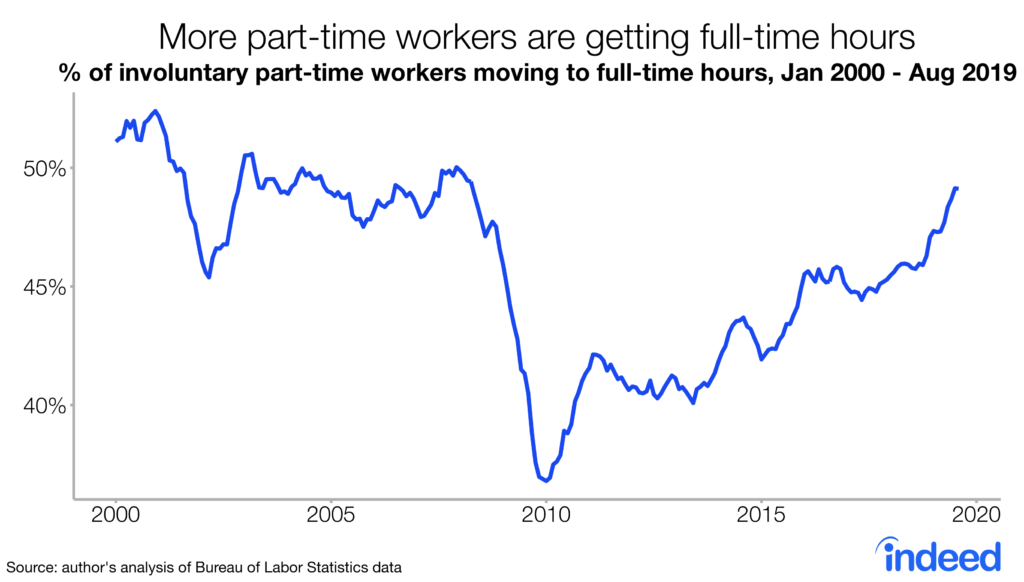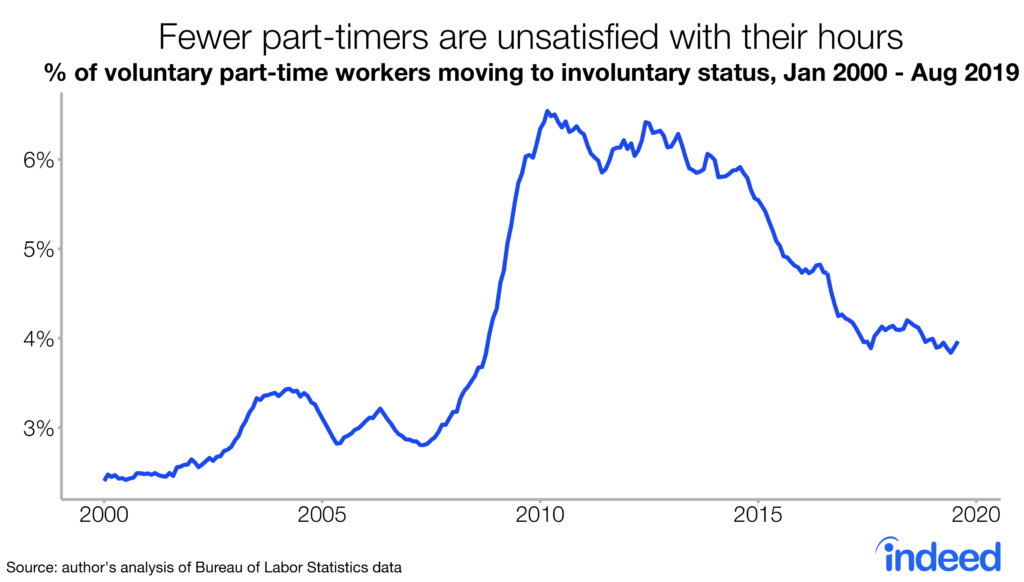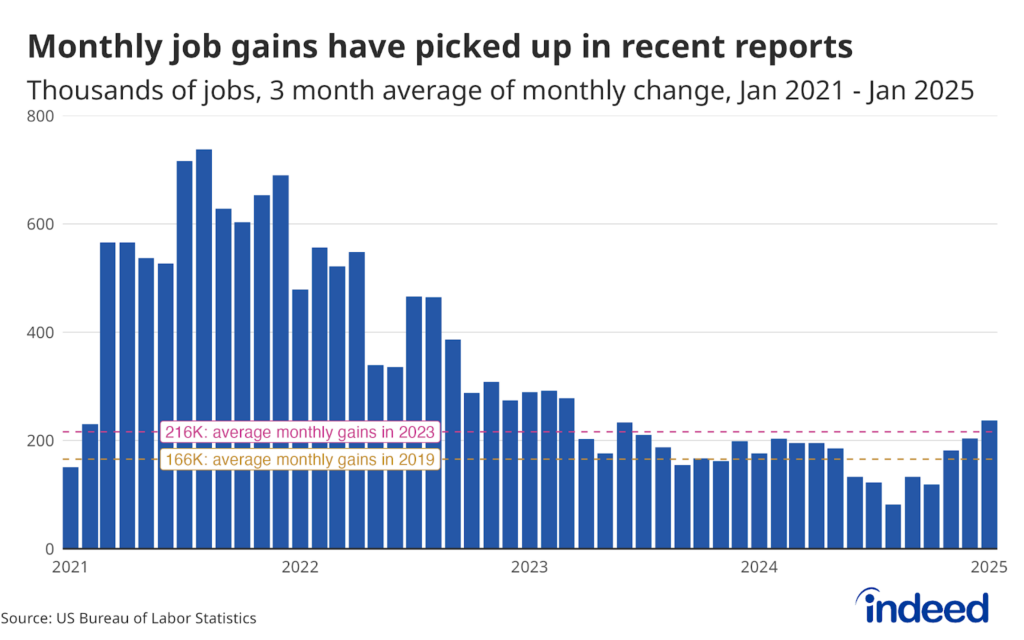Key points
- In August 2019, just under half of all involuntary part-time workers between 25 and 54 had moved into full-time jobs, up from 39% who had found full-time work in 2010, according to an Indeed analysis of Bureau of Labor Statistics data.
- Some 83% of part-time workers report they are working fewer hours by choice, but 50% of them in an Indeed survey note that they don’t want to work a reduced schedule indefinitely.
- To retain employees in a strong economy, employers turn some part-time jobs into full-time positions. To keep part-timers who prefer reduced hours, full-time jobs can be structured to offer some of the advantages of part-time work, such as scheduling flexibility.
As the US economy has strengthened, part-time work has slowly but steadily declined. Some 15.5% of the labor force works part-time, down from a peak of 17.8% during the depths of the Great Recession. Almost all of that decline is due to the shrinking ranks of those working part-time involuntarily, with 83% of current part-time workers saying they chose reduced hours.
But below the surface a fair amount of churn takes place. Involuntary part-time workers who want 35 or more hours a week would like to leave part-time status. But workers who voluntarily choose to work part-time may change their mind as their personal circumstances change or the economy creates new opportunities or challenges for them.
Indeed surveyed involuntary and voluntary part-timers about their journey into part-time work and their employment expectations. We found that the line between involuntary and voluntary part-time workers is not so neat and clean — even those who don’t seek more hours now are likely to want them in the future.
Involuntary part-time workers want full-time work now — and increasingly are getting it
By August 2019, just under half of all involuntary part-time workers between 25 and 54 — considered prime working age — got full-time hours within a year, according to our analysis of Bureau of Labor Statistics data. The share of people going from involuntarily part-time employment to full-time hours has steadily increased since 2010 and accelerated over the past year.
Some 56% of involuntary part-time workers surveyed said that before they started working part-time, they had a full-time job, while 32% were not employed. Asked how they got into part-time work, 34% said they couldn’t find a full-time job. Another 19% initially chose part-time and later decided they would rather work full-time. For another 11%, employers reduced their hours from full- to part-time.
The involuntary part-time workers surveyed had been working a reduced schedule for 25 months on average. Some 64% said they were continuing to seek full-time employment, while 13% reported they had stopped looking for a full-time role after an average search of 13 months. Our survey showed that 84% of involuntary part-timers expect to be employed full-time in the future, with 45% expecting to work a full schedule within a year. Some 34% said their employer had discussed a possible full-time role with them, while 41% thought their employer would offer them a full-time position at some point.

Some 57% of involuntary part-timers said they are working more than one job to make ends meet. Voluntary part-time workers are more confident than involuntary part-timers that they will be able to land a second job if needed. Some 83% said they thought they could find a second job compared with 68% of involuntary part-timers.
Workers who choose part-time status don’t want to stick with it forever
Most part-time workers surveyed said they chose fewer hours. But most of them also said they don’t want to work such a schedule forever.
Some 51% of voluntary part-timers said they were previously employed full-time, while 29% didn’t have a job. Asked why they moved to part-time, 52% said they wanted more flexibility in their lives.
Some 41% of voluntary part-time workers reported they hadn’t expected to be on a reduced schedule for as long as they had been. They expected to work part-time for 19 months on average, though 57% said they had not sought full-time employment. Those who did look for full-time work searched for an average of 10 months.
Some 43% of voluntary part-timers would consider a full-time role if offered. Higher pay, benefits, and a set schedule are the top attractions of a full work week. However, only 20% of such workers had discussed a full-time position with their employer. Of that group, 78% were offered a full-time job, but did not accept it. Still, 50% of voluntary part-timers said they expected to take a full-time role in the future and 71% of them believe they will do so within two years.
A person may prefer to work part-time, but changing personal circumstances can cause them to want more hours. For example, if a member of a part-time worker’s household loses a job, that person may want more hours to make up for the household’s lost income, a common scenario in a recession. In addition, when the labor market weakens, more workers move from voluntarily to involuntarily part-time status, while the reverse occurs when the economy recovers.

Conclusion: Steps for employers
Employers that have a lot of part-time workers often face the question of how to retain part-timers who want to transition to full time. In a strong economy, a good option may be to turn a part-time job into a full-time position.
The problem is different when employees prefer part-time work, but employers want to move them into full-time roles. In those cases, employers can build some of the perceived advantages of part-time work into full-time jobs, such as scheduling flexibility.
Methodology
In July 2019, Indeed surveyed 1,780 U.S. adults employed part-time. Of those, 64% said they were voluntary part-time workers and 36% said they were involuntary. The average age was 39 for voluntary part-time workers and 37 for involuntary part-timers. The survey was conducted at 95% confidence at a +/- 2% margin of error.
All 50 states in the United States were represented in the full survey, with Vermont missing from the voluntary part-time respondents and Montana, New Hampshire, North Dakota, and Wyoming from the involuntary part-timers.
A full description of the methodology used to calculate the flow rates from BLS data can be found in this Hiring Lab post.






